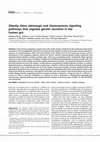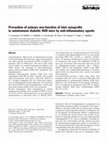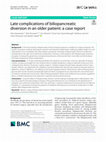Papers by Matthias Lannoo

The FASEB Journal, Jan 10, 2019
Chemosensory signaling in organs such as the mouth and gut contributes to the mechanisms that con... more Chemosensory signaling in organs such as the mouth and gut contributes to the mechanisms that control metabolism. We investigated the chemosensory pathways that regulate secretion of the hunger hormone ghrelin in response to neurotransmitters, bitter and sweet tastants at the cellular level in the human gut mucosa, and the disturbances in this regulatory pathway induced by obesity. Obesity impaired ghrelin protein production and adrenalin-induced ghrelin secretion in fundic cells, which was counterbalanced by somatostatin. Bitter agonists selective for taste receptor type 2 (TAS2Rs), TAS2R5 and TAS2R10 stimulated ghrelin secretion in fundic cells. The stimulatory effect of the broadly tuned bitter agonist, denatonium benzoate, was selectively blunted by obesity in the small intestine but not in the fundus. Luminal glucose concentrations inhibited ghrelin secretion via sodiumdependent glucose cotransporter and taste receptor type 1 member 3. Obesity altered the sensitivity of the ghrelin cell to glucose in the small intestine but not in the fundus. Sweet taste receptor activation inhibited bitter taste signaling of the ghrelin cell. In conclusion, obesity impairs the sympathetic drive that controls ghrelin release in the fundus and affects the sensitivity of the ghrelin cell to bitter and sweet stimuli in the small intestine but not in the fundus. Region-selective targeting of gut taste receptors in obesity is indicated.
Finds and Results from the Swedish Cyprus Expedition: A Gender Perspective at the Medelhavsmuseet, 2003
Gastroenterology, May 1, 2013
Journal of Trace Elements in Medicine and Biology, Mar 1, 2019
Diabetes Care, Sep 1, 2004

Diabetologia, Aug 1, 2003
Aims/hypothesis. High levels of inflammation locally in the graft during the initial days after t... more Aims/hypothesis. High levels of inflammation locally in the graft during the initial days after transplantation can cause primary non-function (PNF) of grafted xenogeneic islets in NOD mice. The aim of this study was to explore in a model of spontaneous diabetes, the NOD mouse, the potential of anti-inflammatory agents in the prevention of PNF after xenogeneic islet transplantation. Methods. Spontaneously diabetic NOD mice were transplanted with 300 rat islets. Animals were treated with acetylsalicylic acid (AsA), rofecoxib, TGF-β or IL-1 receptor antagonist (IL-1ra). Intra-graft expression of inflammation-related molecules was measured by real time PCR 8 h post-transplantation. At the same time point, plasma nitrite levels were measured. Results. Xenogeneic islets transplanted in control spontaneously diabetic mice resulted in PNF in 16 out of 38 mice (42%). Initial graft loss was not altered by administration of rofecoxib (30%) or TGF-β (25%). AsA reduced the rate of rapid graft loss to 8% (p<0.05 vs controls) and administration of IL-1ra even totally prevented PNF (0%, p<0.05 vs controls). Furthermore, all therapies prolonged the mean survival time of xenogeneic islet grafts. The inhibition of PNF by AsA was associated with decreased intra-islet levels of inflammation-related molecules (IL-1, TNF-α, iNOS, COX-2) and chemokines (MCP-1 and MIP-3α). Finally, also a diminished production of systemic nitrite levels was observed in AsA-and IL-1ra-treated islet recipients. Conclusions/Interpretation. These data show that treatment with AsA or IL-1ra prevents PNF after islet transplantation in spontaneously diabetic NOD mice. Moreover, the involvement of non-specific inflammation is recognized in xenogeneic islet PNF in spontaneously diabetic NOD mice. [Diabetologia (2003) 46:1115-1123]
Obesity Surgery, Oct 15, 2020
Transplantation, Oct 6, 2022

Gastroenterology, May 1, 2013
patients satisfied ROME criteria for CVS, while 27 (3.2%) had a gastroenterologist confirmed diag... more patients satisfied ROME criteria for CVS, while 27 (3.2%) had a gastroenterologist confirmed diagnosis of CVS. Overall, the ROME CVS criteria detected 100% of the clinically confirmed CVS cases, yielding sensitivity and NPVs of 100%; however, a substantial number of false positive cases were detected (n=135, 16.2%), resulting in specificity and PPV values of 83.2% and 16.6%, respectively. Of the false positive cases, 100 (74.1%) met ROME criteria for: functional dyspepsia in 86 (63.7%), functional vomiting in 49(36%), chronic idiopathic nausea in 24 (17.8%), functional heartburn in 68 (50.4%), and functional chest pain in 23 (17.0%). There were no significant differences in age, gender, reported symptom severity/ frequency, HRQOL, or somatization scores between expert clinician diagnosis and ROMEIII diagnosis of CVS (p.0.20 for each). Self-report of vomiting frequency and symptomfree intervals (Rome III RDQ Questions 28 and 31) also did not distinguish between the two CVS groups (P.0.16 for each). Tricyclic antidepressants were predominantly used for prophylaxis (76.9%); zonisamide (42.3%), topiramate (11.5%) and levatiracetam (7.7%) were used less often. Conclusions: Questionnaires overestimate CVS diagnosis, and cannot be substituted for expert clinician evaluation of patients. Functional foregut syndromes often confound diagnosis, but prophylactic management recommendations (i.e. neuromodulator use) may be similar for confounding diagnoses.

Obesity Surgery, Apr 30, 2020
For patients with advanced heart failure, left ventricular assist device (LVAD) can serve as a br... more For patients with advanced heart failure, left ventricular assist device (LVAD) can serve as a bridge to heart transplantation. Patients with class II obesity are eligible for implantation of LVAD, but do not meet criteria for cardiac transplant listing. Laparoscopic sleeve gastrectomy (LSG) is proposed as weight losing modality in order to reach the NYHA criteria for listing. In our center, three patients on LVAD with need for weight reducing therapy were treated with laparoscopic sleeve gastrectomy. We reviewed our data retrospectively and compared it to the literature. Successful weight loss was achieved in all patients, without postoperative adverse events. Two out of three were listed on transplant waiting list. Our results are similar to those described in other series. BACKGROUND Left Ventricular Assist Device (LVAD) is a therapeutic option as bridge to orthotopic heart transplantation (OHT) in case of end stage cardiac failure. Obesity is associated with a poor outcome after OHT (1), for patients with severe obesity, it is recommended to achieve a BMI of less than 35 kg/m 2 before listing for OHT (1,2). Obesity is a worldwide expanding epidemic, in both developed and developing countries. (3,4) There is a strong association between obesity and heart failure: up to 35-43% of patients with heart failure are overweight or obese. (4-6) The Framingham heart study suggests that for every 1kg/m 2 increase in BMI the risk of developing heart failure increases by 5% in men and 7% in women. (7,8) In conclusion one can expect that more and more patients with obesity with end stage heart failure will not meet criteria for OHT due to obesity. Bariatric surgery may play a

The Lancet Gastroenterology & Hepatology, Mar 1, 2021
The growing obesity epidemic explains the increased demand for bariatric and metabolic surgery. T... more The growing obesity epidemic explains the increased demand for bariatric and metabolic surgery. To date, Sleeve Gastrectomy (SG) and Roux-en-Y Gastric Bypass (RYGB) are the most common performed procedures. Originally, bariatric procedures were described as purely restrictive, malabsorptive or combined restrictive-malabsorptive procedures limiting food intake and/or nutrient absorption. Nowadays, the anatomical alterations are known to affect the gastrointestinal physiology. Consequently, these changes affect the digestion and absorption of nutrients and drugs. Therefore, understanding the gastrointestinal physiology per se is crucial for the prevention of postoperative nutritional deficiencies and the optimization of postoperative drug therapy. In this review, we summarize the current knowledge on the impact of SG and RYGB on gastrointestinal physiology and bring attention to the knowledge gaps in the field. Concisely, available (pre)clinical research indicates that SG accelerates liquid and solid gastric emptying, accelerates small intestinal transit and increases bile acid serum levels. The effect on gastrointestinal acidity, gastric and pancreatic secretions, surface area and colonic transit remains largely unknown. Moreover, RYGB diminishes gastric acid secretion, accelerates liquid gastric emptying and increases bile acid serum levels. The effect on intestinal pH, solid gastric emptying, intestinal transit time, gastric enzyme secretions and surface area remains largely unknown.
Obesity Surgery, Jun 15, 2022
Acta Gastro-enterologica Belgica, 2012

BMC Geriatrics, Nov 4, 2021
Background: In the mid-seventies, biliopancreatic diversion became popular as weight-loss surgery... more Background: In the mid-seventies, biliopancreatic diversion became popular as weight-loss surgery procedure. This bariatric procedure combines distal gastric resection and intestinal malabsorption, leading to greater weight loss and improvement of co-morbidities than other bariatric procedures. Nowadays, biliopancreatic diversion has become obsolete due to the high risk of nutritional complications. However, current patients with biliopancreatic diversions are aging. Consequently, geriatricians and general practitioners will encounter them more often and will be faced with the consequences of late complications. Case presentation: A 74-year old female presented with weakness, recurrent falls, confusion, episodes of irresponsiveness, anorexia and weight loss. Her medical history included osteoporosis, herpes encephalitis 8 years prior and a biliopancreatic diversion (Scopinaro surgery) at age 52. Cerebral imaging showed herpes sequelae without major atrophy. Delirium was diagnosed with underlying nutritional deficiencies. Biochemical screening indicated vitamin A deficiency, vitamin E deficiency, zinc deficiency and severe hypoalbuminemia. While thiamin level and fasting blood glucose were normal. However, postprandial hyperinsulinemic hypoglycemia was observed with concomitant signs of confusion and blurred consciousness. After initiating parenteral nutrition with additional micronutrient supplementation, a marked improvement was observed in cognitive and physical functioning. Conclusions: Long-term effects of biliopancreatic diversion remain relatively underreported in older patients. However, the anatomical and physiological changes of the gastrointestinal tract can contribute to the development of metabolic and nutritional complications that may culminate in cognitive impairment, functional decline and delirium. Therefore, it is warranted to evaluate the presence of metabolic disturbances and nutritional complications in older patients after biliopancreatic diversion.

Obesity Surgery, Oct 6, 2021
This scoping review summarizes current evidence with regard to the impact of bariatric surgery on... more This scoping review summarizes current evidence with regard to the impact of bariatric surgery on psychological health in adults with obesity. While a large body of evidence reports major metabolic benefit and improved quality of life, there is also ample evidence suggesting an increased incidence of self-harming behavior, a greater likelihood of developing an alcohol problem and higher rates of completed suicide amongst bariatric patients. Being able to identify the 'at risk' patient population requires more longitudinal research into the risk factors for psychological complications after bariatric surgery. Bariatric surgery remains an extremely valuable long-term treatment option for managing obesity, however there is a need to invest in mitigating psychological complications after the surgery, such as depression, alcohol consumption, and other self-harming behaviors. MS #OBSU-D-21-00379 2 Key Points: 1. Quality of life improves in patients that undergo bariatric surgery. 2. Increased risk for depression, substance abuse, and self-harm after bariatric surgery. 3. More longitudinal research is necessary to identify at risk patient population. 4. Uniformity in screening methods, instruments are necessary to decrease complications.

Journal of Clinical Medicine, Aug 24, 2020
Background: Pregnancies in women with a history of bariatric surgery are becoming increasingly pr... more Background: Pregnancies in women with a history of bariatric surgery are becoming increasingly prevalent. Surgically induced metabolic changes benefit mother and child, but can also lead to some adverse pregnancy outcomes. Knowledge about glucose homeostasis in these pregnancies could elucidate some of the mechanisms behind these outcomes. This review focusses on glucose homeostasis and birth weight. Methods: We considered papers dealing with glucose homeostasis, gestational diabetes mellitus (GDM) and/or small-for-gestational age infants (SGA) in pregnancies with a history of sleeve gastrectomy (SG) or Roux-en-y gastric bypass (RYGB). Results: Since an OGTT is unreliable to diagnose GDM in a pregnancy after bariatric surgery, the true incidence of GDM is unknown. Alternative screening strategies are needed. Furthermore, these pregnancies are marked by frequent hypoglycemic events as well as wide and rapid glycemic excursions, an issue that is very likely underreported. There is a lack of uniformity in reporting key outcomes and a large variation in study design and control population. Conclusion: Alteration of glucose homeostasis in a pregnancy after bariatric surgery should be further studied using unequivocal definition of key concepts. Glycemic control may prove to be a modifiable risk factor for adverse pregnancy outcomes such as the delivery of an SGA baby.

Advances in Nutrition, Jul 1, 2015
Pregnant and postpartum women with a history of bariatric surgery are at risk of micronutrient de... more Pregnant and postpartum women with a history of bariatric surgery are at risk of micronutrient deficiencies as a result of the combination of physiologic changes related to pregnancy and iatrogenic postoperative alterations in the absorption and metabolism of crucial nutrients. This systematic review investigates micronutrient deficiencies and related adverse clinical outcomes in pregnant and postpartum women after bariatric surgery. A systematic approach involving critical appraisal was conducted independently by 2 researchers to examine deficiencies of phylloquinone, folate, iron, calcium, zinc, magnesium, iodide, copper, and vitamins A, D, and B-12 in pregnant and postpartum women after bariatric surgery, together with subsequent outcomes in the neonates. The search identified 29 relevant cases and 8 cohort studies. The quality of reporting among the case reports was weak according to the criteria based on the CARE (CAse REporting) guidelines as was that for the cohort studies based on the criteria from the Cohort Study Quality Assessment list of the Dutch Cochrane Center. The most common adverse neonatal outcomes related to maternal micronutrient deficiencies include visual complications (vitamin A), intracranial hemorrhage (phylloquinone), neurological and developmental impairment (vitamin B-12), and neural tube defects (folate). On the basis of the systematically collected information, we conclude that the evidence on micronutrient deficiencies in pregnant and postpartum women after bariatric surgery and subsequent adverse neonatal outcomes remains weak and inconclusive.











Uploads
Papers by Matthias Lannoo